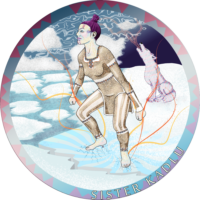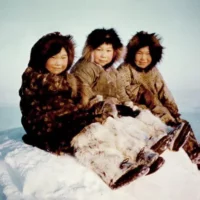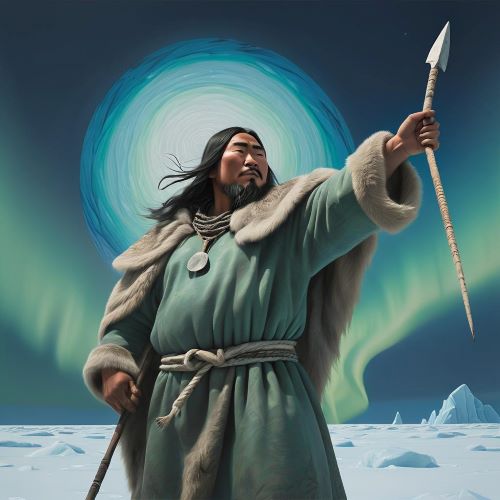Kadlu : The Thunderous Sister
Listen
At a glance
| Description | |
|---|---|
| Origin | Inuit Mythology |
| Classification | Gods |
| Family Members | Kweetoo, Inirtoq (Sisters) |
| Region | Alaska, Greenland, Siberia, Canada |
| Associated With | Lightning |
Kadlu
Introduction
Kadlu, a prominent figure in Inuit mythology, forms part of a celestial trio responsible for creating thundery weather. Within the rich tapestry of Inuit beliefs, Kadlu emerges as a powerful and intriguing character. In the expansive and icy realms of the Arctic, Kadlu resides as a formidable goddess embodying the raw energy of thunder—an awe-inspiring force essential for the well-being of the Inuit people.
Physical Traits
Kadlu’s physical appearance remains largely undescribed in Inuit legends, with the focus primarily on her actions and the power she embodies. However, interpretations sometimes portray her as a youthful woman bursting with boundless energy, reflecting the untamed nature of thunder. While explicit descriptions of Kadlu’s physical traits are scarce, she is often envisioned as a radiant figure encapsulating the essence of thunder and weather. Across the diverse cultural tapestry of the Inuit, depictions of Kadlu vary, presenting a range of perspectives. In some renditions, she is depicted as a towering figure with skin aglow in the otherworldly hues of the Northern Lights. Alternatively, she is imagined as a youthful being, her eyes gleaming like celestial flames, and her laughter resonating in the crisp Arctic air.
Family
Kadlu is part of a trinity of sisters, each possessing unique abilities that contribute to the creation of thundery weather. Her sister Kweetoo creates lightning by rubbing stones together, while the third sister, Ignirtoq, generates lightning by striking stones and is associated with rainfall due to her unusual method of urination. This familial connection highlights the interconnectedness inherent in Inuit cosmology, emphasizing Kadlu’s crucial role in maintaining the delicate balance of the elements.
Kadlu is not a solitary figure but an integral part of a powerful trio of sisters who govern the weather. Kweetoo, the middle sister, masters lightning, using stones to create illuminating streaks across the sky. Meanwhile, Inirtoq, the youngest, controls rain, conjuring it through a combination of stone striking and a touch of the fantastical with her unusual ability. Together, these sisters orchestrate the forces that sustain life in the harsh Arctic environment, ensuring balance and providing essential moisture to the parched tundra.
Other names
While Kadlu is primarily associated with Inuit mythology, it’s important to recognize that names can carry different meanings and associations across various cultures. For example, in Hindu mythology, the goddess Kadrû is revered as the mother of snakes. Despite this, there is no direct connection between Kadlu and Kadrû, underscoring the intriguing ways in which names and their meanings can traverse different cultural and mythological contexts.
Within the rich oral tradition of the Inuit people, storytelling allows for variations, including different names for Kadlu depending on the region and the storyteller. Some variations include Qadlu, Tudlik, or simply “the Thunder Woman.” These subtle variations highlight the multifaceted nature of thunder and the reverence it inspires across diverse communities.
Powers and Abilities
Kadlu’s primary domain is thunder, and legends describe her creating its booming sound in various ways. In some tales, she jumps on hollow ice floes, mimicking the experience of thunder rolling across the frozen landscape. Other stories depict her using more playful methods, such as singing loudly or rubbing together dried seal skins. This playful association with thunder reflects the deep respect for, yet comfort with, the power of nature within Inuit culture.
Beyond thunder, Kadlu’s influence extends to the creation of clouds, a crucial element in bringing rain to the thirsty Arctic lands. The act of jumping on ice may symbolically represent the churning of the atmosphere that precedes a storm, highlighting the imaginative and symbolic nature of Inuit mythology.
It’s important to note that while Kadlu and her sisters wield significant power, their influence is not absolute. The Inuit believed that shamans, known as angakkuq, could also influence the weather through rituals and offerings. This complex interplay between deities, human intervention, and the natural world underscores the profound belief in the interconnectedness of all things within Inuit cosmology.
Modern Day Influence
Kadlu’s enduring legacy is deeply rooted within Inuit culture, where artists frequently incorporate her image into sculptures and paintings alongside her sisters, contributing to the preservation and celebration of Inuit mythology. Through storytelling, a cornerstone of Inuit tradition, tales of Kadlu are passed down through generations, reinforcing the importance of respecting nature’s power as embodied by Kadlu. This cultural continuity highlights the profound impact of mythological figures in shaping Inuit identity and fostering a connection to the natural world.
Beyond cultural expressions, Kadlu’s name has made an intriguing entrance into the scientific realm. The mineral Qaqortoqite, a rare type of iron found in Greenland, derives its name from “Qaqortoq,” a Greenlandic word for thunder, which itself originates from Kadlu’s name. This scientific homage underscores the enduring connection between Inuit mythology and the natural environment, bridging traditional knowledge with modern scientific discovery and adding a layer of cultural significance to geological findings.
Kadlu’s story presents a unique perspective on thunder, depicting it as a playful act created by a mischievous goddess rather than a source of fear. This narrative challenges conventional views of natural phenomena and reflects the Inuit ethos of finding beauty and wonder in harsh environments. Kadlu’s enduring presence serves as a reminder to respect nature’s power while maintaining a sense of awe and curiosity in the face of its grandeur. While explicit references to Kadlu in modern culture may not be widespread, the broader influence of Inuit mythology is evident across various forms of media and literature, where themes and characters from these myths continue to inspire and captivate audiences, providing insights into the rich cultural heritage of the Inuit people and fostering a deeper appreciation for indigenous traditions and the natural world.
Related Images
Frequently Asked Questions
What is lorem Ipsum?
I am text block. Click edit button to change this text. Lorem ipsum dolor sit amet, consectetur adipiscing elit. Ut elit tellus, luctus nec ullamcorper mattis, pulvinar dapibus leo.
What is lorem Ipsum?
I am text block. Click edit button to change this text. Lorem ipsum dolor sit amet, consectetur adipiscing elit. Ut elit tellus, luctus nec ullamcorper mattis, pulvinar dapibus leo.
What is lorem Ipsum?
I am text block. Click edit button to change this text. Lorem ipsum dolor sit amet, consectetur adipiscing elit. Ut elit tellus, luctus nec ullamcorper mattis, pulvinar dapibus leo.
What is lorem Ipsum?
I am text block. Click edit button to change this text. Lorem ipsum dolor sit amet, consectetur adipiscing elit. Ut elit tellus, luctus nec ullamcorper mattis, pulvinar dapibus leo.
What is lorem Ipsum?
I am text block. Click edit button to change this text. Lorem ipsum dolor sit amet, consectetur adipiscing elit. Ut elit tellus, luctus nec ullamcorper mattis, pulvinar dapibus leo.










